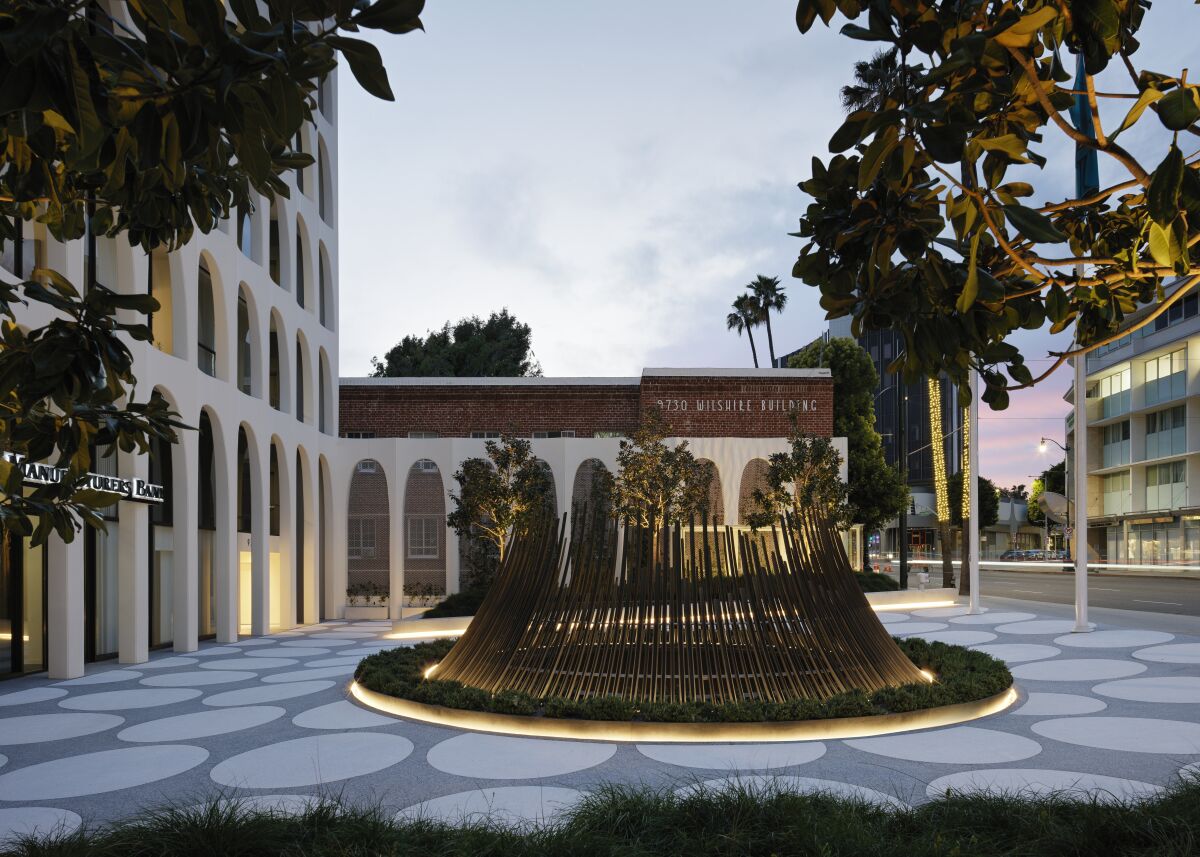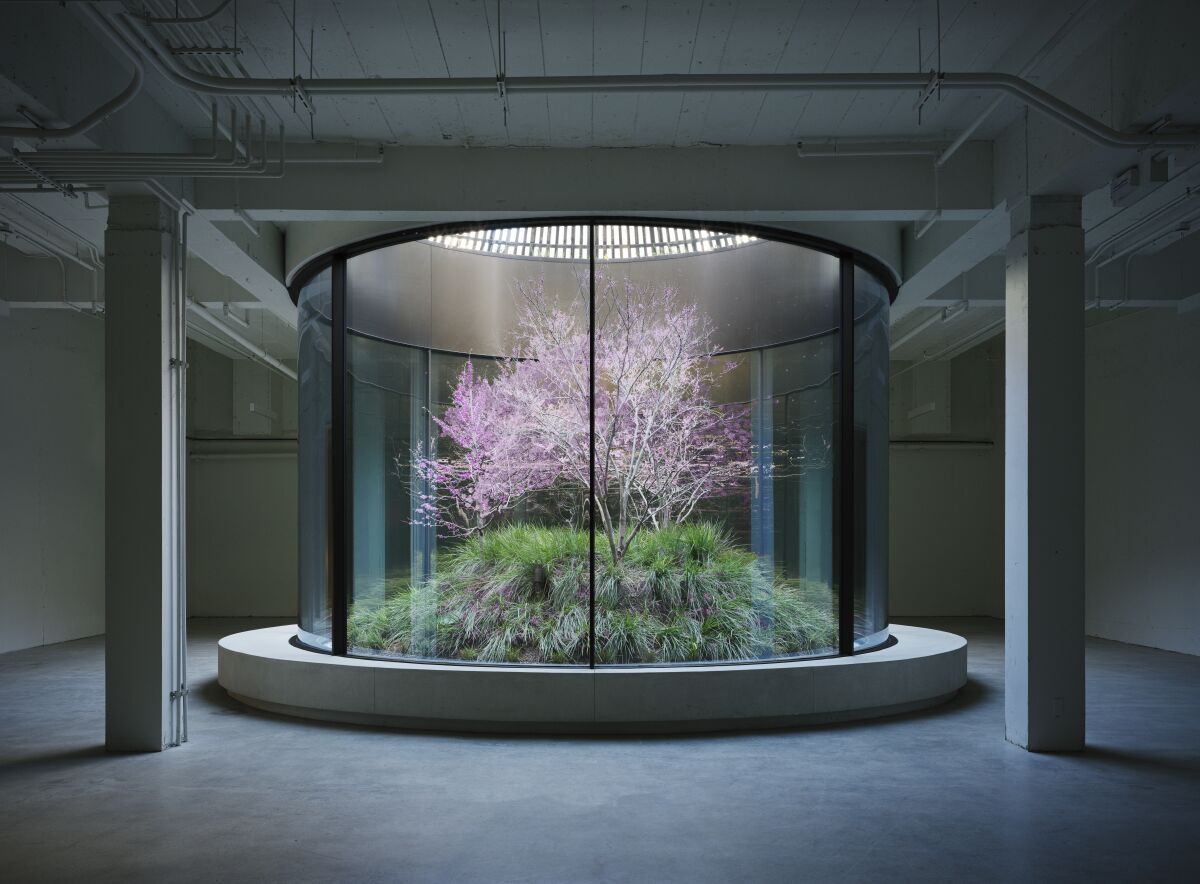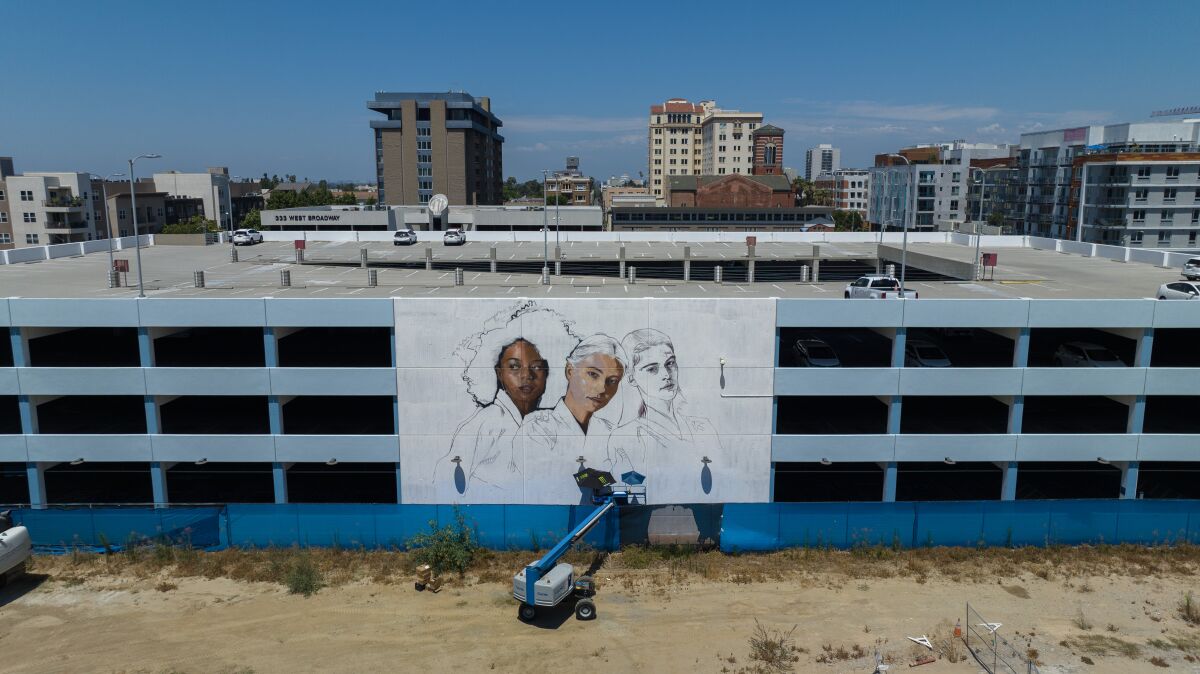Greetings from the word factory! I’m Carolina A. Miranda, arts and design columnist for the Los Angeles Times, awaiting the hurricane deluge, because climate change is really real. In the meantime, here’s all the essential arts news:
A thoughtful refresh
Edward Durell Stone produced far more famous designs than the eight-story bank building on Wilshire Boulevard at South McCarty Drive in Beverly Hills. In the 1930s, he did the interiors for Radio City Music Hall in New York City. With Philip Goodwin, he went on to produce an International Style building for the Museum of Modern Art, and in the late 1950s, he created an eye-catching, columned embassy for the United States in New Delhi that was draped with textile block screens. One of his best known works is the massive Kennedy Center complex in Washington, D.C., completed in 1971, a Modernist take on the Classical temple.
But his Perpetual Savings and Loan building in Beverly Hills (later known as the Home Federal Savings/Pacific Mercantile Bank building), completed in 1962, has always caught my eye for its geometries: a wedding cake of stacked, perfectly symmetrical Modernist arches that bears an uncanny resemblance to the Palazzo della Civiltà Italiana, a ’30s-era building designed by Giovanni Guerrini, Ernesto Bruno and Mario Romano for fascist leader Benito Mussolini.

A view of the plaza before Edward Durell Stone’s bank building, after a renovation by Montalba Architects.
(Kevin Scott)
It’s an uncomfortable association, but to be clear, Stone was influenced by Italian architecture at large. Married to Italian fashion writer Maria Elena Torchio, he once said that after they wed, “Maria’s fine Italian hand began to show in my attire and my work.” His New York Cultural Center from 1964, affectionately known as the “Lollipop Building” — and since remodeled beyond recognition — was a Modern paean to the architecture of Venetian palazzos.
In addition to the bank, Stone designed numerous structures in California (for a time he maintained an office in L.A.), including the Stanford Medical Center in Palo Alto (completed in 1959), the ornate Beckman Auditorium at CalTech in Pasadena (1964) and the Wilshire Colonnade in Los Angeles (1970), constructed for financier Howard Ahmanson.
Newsletter
Your essential guide to the arts in L.A.
Get Carolina A. Miranda’s weekly newsletter for what’s happening, plus openings, critics’ picks and more.
You may occasionally receive promotional content from the Los Angeles Times.
The bank project drew attention for its symmetries and also for the ebullient, large-scale sculpture by Harry Bertoia at the heart of the plaza. Titled “Sunburst,” the piece resembled a massive dandelion. (A newspaper article from the era shows a little boy holding a dandelion while standing in front of it.) But the outdoor location made the sculpture difficult to care for and it was ultimately relocated to a library in Omaha.
Fast forward to 2021. Like many buildings of the era, parts of the complex were in need of a refresh. The lobby needed an update, the fountain that crowned the plaza had fallen into disuse because it leaked into a storage area below and an open stairwell that descended from the street to the basement had become a de facto garbage can.
Montalba Architects, an L.A.-based firm with offices in Lausanne, Switzerland, took on the job — one that founder David Montalba describes as having more to do with subtraction than addition.

A view of the sunken light well and garden designed by Montalba Architects for Edward Durell Stone’s Beverly Hills bank building.
(Kevin Scott)
For starters, the architects ditched the fountain and instead used the circular space that it once occupied to carve a similarly-shaped light well into the building’s basement, drawing daylight into an area that had previously been illuminated only with artificial light. Within the light well, a small sunken garden also brings a hint of nature to the space.
This move has completely transformed the basement, which was once used for document storage. With the remodel, what was once a dim concrete bunker could serve as additional office space or a public commercial venue (a lounge would seem right), since it has direct access to the street via a staircase that is now sheltered by a set of glass doors. (Elevators within the structure likewise maintain accessibility.)
At plaza level, the old fountain is now evoked by a sculpture composed of a series of hammered bronze darts with an arching form that echoes the upward flow of water. The plaza’s terrazzo, with its circular patterns, has also gotten a refurbish, and lining the perimeter of the space you’ll now find white concrete planters that provide a comfortable space for neighborhood workers to sit and enjoy their lunch.

Montalba’s renovation of the lobby uses materials that nod to Midcentury architecture, such as travertine, walnut and bronze.
(Kevin Scott)
The changes are significant, but not in a showy way. “We wanted to do something impactful,” says Montalba, “but that honored the building.”
“Someone who drives by,” he adds, “might not even know anything has changed.”
On and off the stage
”It’s August,” Times theater critic Charles McNulty writes, “and our brains are sluggish if not completely shut off.” And at the Ahmanson Theater, the comedy “Peter Pan Goes Wrong” offers humor and hijinks. Presented by Mischief, a popular British theater company that stages comedic works inspired by disaster, this is the story of a group of bumbling actors who can’t quite get a production of “Peter Pan” off the ground. “This isn’t what anyone would call a prestige hit,” writes McNulty. “This undemanding frolic only wants to restore your sense of childlike play.”

“Peter Pan Goes Wrong” is all about anything and everything that can go wrong during a theatrical production.
(Jeremy Daniel)
Music and film Twitter — I’m still not calling it X — have been arguing about the appropriateness of a prosthetic nose worn by actor Bradley Cooper in his role as Leonard Bernstein in “Maestro.” Bernstein’s children have come out in support of the actor and the decision to use a prosthetic: “It happens to be true that Leonard Bernstein had a nice, big nose. Bradley chose to use makeup to amplify his resemblance, and we’re perfectly fine with that. We’re also certain that our dad would have been fine with it as well.”
Critic Mark Harris checks in with an interesting essay on the subject: “I am not in sympathy with a view of acting that centers an actor’s identity rather than a character, or with the blanket disqualification of certain kinds of transformational artistry that is inherent in that approach, and I’m troubled when Jewishness is enlisted to support it.”
In and out of the galleries
In Long Beach, the Long Beach Walls and Art Renzei art festival will bring new murals to sites around the city. This year’s event, reports The Times’ Steven Vargas, will add a dozen murals to schools, parking structures and other buildings.

A mural by Royyal Dog in progress on the south side of West Broadway Parking in Long Beach.
(Brian van der Brug / Los Angeles Times)
L.A. painter Lari Pittman is opening a show at Lehmann Maupin gallery in New York that is inspired by the cacophony and ebullience of cities. “I absolutely love driving through the city, just observing the built environment,” he tells Hyperallergic’s Matt Stromberg. “If I can avoid the freeways, I always do it because there’s no stimulus. It’s dead.”
Chelsea Hylton in De Los has a report on a small new institution devoted to showcasing Central American Garifuna Culture in Los Angeles. The museum is run out of a home in South L.A. and was established by documentarian Rubén Reyes, who wanted to create a place that could offer a point of connection for the culture.
Enjoying this newsletter? Consider subscribing to the Los Angeles Times
Your support helps us deliver the news that matters most. Become a subscriber.
Ukrainanian sculptor Mikhail Reva was once best known for his large-scale public pieces of stylized human figures. But since the Russian invasion, the Odesa-based artist has turned to the detritus of war as his principal material, creating assemblages that speak to the politics of the moment. “For me, it’s like putting together a giant jigsaw puzzle, a puzzle made up of horror and chaos,” he tells Times correspondent Laura King. “That is the life of this war — what our lives have become.”

Mikhail Reva welds war debris into a sculpture in his Odesa workshop.
(Marcus Yam / Los Angeles Times)
Essential happenings
Steven Vargas has got the guide to going out, starting with REDCAT’s New Original Works Festival, on view through Sept. 2!

JOJO ABOT’s immersive opera “A God of Her Own Making” will be on view as part of REDCAT’s festival.
(Nick Berardi x JOJO ABOT)
Also, may I recommend the absolutely sumptuous show of Suchitra Mattai’s textile pieces at Roberts Projects, on view until Aug. 26.
Moves
Shauna Quill has been named the new director of Santa Barbara’s Music Academy. A trained flutist, she is currently wrapping up her tenure as executive director of the New York Youth Symphony and will assume her new post in November. She replaces outgoing director Scott Reed, who had held the president and CEO positions since 2010.

Shauna Quill will assume leadership of Santa Barbara’s Music Academy.
(Joshua Wang)
The Cooper Hewitt in New York has announced its 2023 National Design Awards. Among the winners are L.A. interior design firm the Archers, Apple creative director Arem Duplessis, graphic designer Seymour Chwast, author and graphic designer Clement Mok and designer and typographer Beatriz Lozano.
And the Colburn School has announced its 2023-24 season, which will include Esa-Pekka Salonen conducting Shostakovich, Brahms and Ogonek at the Soraya.
Passages
Artist Hideo Sakata, who survived the atomic bombing at Nagasaki, and helped establish Lantern of the East Los Angeles, a group that saw “Eastern aesthetic sensibilities as an important counterforce to the Western-dominated tendencies of contemporary art,” has died at 87. Contributor Ana Iwataki has an obituary.

Hideo Sakata in his studio, circa 1950.
(Fonje de Vre)
Renata Scotto, an Italian soprano known for her charismatic stage presence in her many roles at New York’s Metropolitan Opera, has died at 89.
In the news
— What led to the extinction of megafauna such as saber-toothed cats and mammoths? Research out of the La Brea Tar Pits points to climate change and human activity.
— “When it comes to covering the planet with carbon stampings, the art world itself is a huge, avaricious, monstrous Big Foot.” Waldemar Januszczak has a searingly good piece in the Times of London about the hypocrisy of environmental shows by an art world that can’t get enough art fairs and private jets.
— Speaking of footprints, Natalia Molina has a great essay about tourism in the age of Instagram: “Our search for Instagrammable views has remade whole local economies and environments.”
— The Orlando Museum of Art is suing its former director, Aaron De Groft, alleging that he was trying to profit off of fake Basquiats shown at the museum.
— This review makes me look forward to reading Howard French’s “Born in Blackness” about Africa’s central role in the development of global culture.
— At a mall in Puerto Rico, you can buy a Walter Mercado cape.
— How the production designers for “The Last of Us” created its crumbling U.S. cities.
— The nightmare of living next to the house featured in HGTV’s “Barbie Dreamhouse Challenge.”
— Rebecca Jennings deconstructs the summer of “girl.”
And last but not least …
This surreal, mildly creepy tale about house sprites by Hiromi Kawakami.
Stay connected with us on social media platform for instant update click here to join our Twitter, & Facebook
We are now on Telegram. Click here to join our channel (@TechiUpdate) and stay updated with the latest Technology headlines.
For all the latest Art-Culture News Click Here
